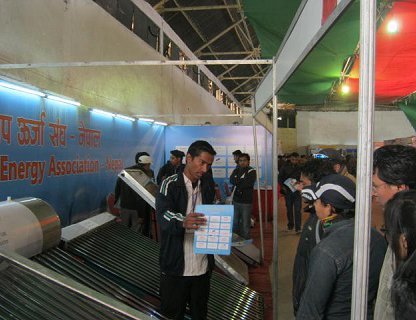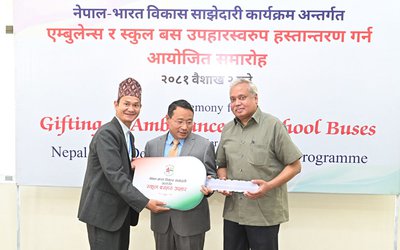
Jeewan Singh Shrestha, director of technology, Danphe Energy Pvt. Ltd, never realized that the common people would rush to an exhibition organized to explore the possibility to switch to alternative energy.
"Hundreds of people came to enquire with us about the products and costs. I am very much encouraged by the response," said Shrestha.
Navaraj Kunwar, managing director of Nepal Energy Development Company Pvt. Ltd, has similar experiences. "There is a huge untapped market in urban areas," said Kunwar.
Amrit Singh Thapa, Managing Director of Energy.com , is equally enthusiastic. Various entrepreneurs coming to take part in the exhibition have their own experiences to share.
It took almost two decades for the Alternative Energy Promotion Center to disseminate the information that alternative energy sources can provide a constant source of power supply in the urban areas. As an acute power shortage is now an urban reality today, the people have no option other than to go for alternative energy.
With the number of people using alternative energy going up, the demand for the related products has gone up.
"Nepal has a huge potential for solar energy. Around 2.920 GWh of energy per year can be harnessed by utilizing just 0.01 percent of the total land area of Nepal for solar energy," said Executive Director of AEPC Professor Dr. Govinda Pokharel.
As the demand grows, the issue of quality has also come to the surface. With the initiative of the Executive Director of AEPC, Professor Dr. Pokharel, a set of standards for the use of solar energy has been issued. Although a group of solar appliances opposed the AEPC's move to place the standards, Professor Dr. Pokharel's stand finally prevailed.
As urban households are facing an acute shortage of power, the number of people searching for alternative power has gone up. The presence of huge number of people in the exhibition for alternative energy showed that the people are willing to move to solar, wind or biogas as alternative sources of energy.
At the exhibition, choices were varied, with the stalls full of Rs. 2500.00 solar tukis to solar power 10 A for home appliances, bio gas plants, solar water heaters, wind, briquettes and micro hydro equipment.
Looking at the various alternative energy sources displayed at the two-day-long renewable energy exhibition at Bhrikutimandap, the people of various walks of life have started to think how quickly to move to the alternative energy source. Presently around 12 percent of the population are using electricity from alternative energy.
Despite the high demand, the lack of policy on promoting the alternative energy has been holding back the country´s progress. For instance, according to FNCCI, Nepali industrial sector incurs a monthly loss of Rs 5 billion due to power shortage.
“If Rs 25 billion is invested in alternative energy development, the industries would be relieved of power crisis for good,” said Executive Director of Alternative Energy Promotion Center (AEPC) Dr. Govinda Raj Pokharel.
Although the government has done little to encourage the people to use alternative energy, Prime Minister Baburam Bhattarai has been harping on a populist rhythm.
"Every household in Nepal will have clean energy solutions and indoor air pollution free kitchen by 2017," said Bhattarai. He did not elaborate how that can be made possible.
People involved in the alternative energy sector did not buy prime minister Bhattarai's commitment. "Until and unless the government introduces a policy to attract private sector investment in the renewable energy sector, the country will continue to be plagued by power crisis," said executive director of Nepal Biogas Promotion Association Bishnu Belbase.
“At a time when the people are facing acute power crisis, alternative energy development will bring a huge relief,” said Belbase. “If the government is genuinely concerned about the people, it will definitely bring policies to encourage investment in alternative energy development."
Although the initial cost of alternative energy solutio is a little high, it will turn out to be cheaper when it is used for a long time. Visitors who came to see the exhibition questioned about the cost.
"Alternative energy solutions are cheaper in the longer term. Of course, it is initially a little bit expensive, but in the long run alternative energy solutions are cheaper than the traditional sources,” said Pokharel
Resha Piya, senior energy officer at AEPC said the exhibition attracted people from all walks of life. “In more than 100 stalls people are getting to learn about renewable energy solutions.
“Some are even buying the products,” she said. “The exhibition basically has 3 goals -- raising awareness among the public, influencing policy makers and attracting private and banking sector to invest in this field,” Piya added.
- TANAHU HYDROPOWER PROEJCT: A Significant Achievement
- Apr 15, 2024
- AMBASSADOR HANAN GODAR: Sharing Pain With A Nepali Family
- Mar 30, 2024
- VISIT OF KfW AND EIB TO NEPAL : Mission Matters
- Mar 25, 2024
- NEPAL BRITAIN SOCIETY: Pratima Pande's Leadership
- Mar 24, 2024
- NEPAL ARMY DAY: Time To Recall Glory
- Mar 15, 2024
















